A decade or so ago, I was sitting in front of my television set watching St Joseph’s College, Hunters Hill, playing St Ignatius’ College, Riverview. After about 15 minutes, the telephone rang. “How good is he!” my son Zolton yelled out down the line.
The “he” was Kurtley Beale. And he wasn’t just good.
He was brilliant, sensational, just add in the superlatives.
Playing number ten for Joeys, Beale dominated the match with incisive running, sleight-of-hand passing – both short and long – cunning little kicks and generally playing, on attack and defence, as if he were four players. He helped created the impression that Joeys had about 18 players on the field.
Beale became a professional rugby player at age 16. He attended his first Wallabies camp, invited by coach John Connolly, when he was 15. In 2010, he kicked a monster long-range penalty on full-time at Bloemfontein, clinching Australia’s first victory at altitude against the Springboks in 47 years.
He had a brilliant 2011 Rugby World Cup tournament and his absence in the semi-final final virtually handed the Test – and the Cup – to the All Blacks.
He was a key player in the Waratahs winning their first and only Super Rugby title. And this season, after coming back from a stint with English club Wasps, he has been an outstanding contributor to a Wallabies side that is attaining some credibility.
Despite all this success, it is fair to say Beale has not achieved in his 67 Tests the sort of record, accomplishments and leadership positions that his incipient genius as a schoolboy star suggested would be his destiny.
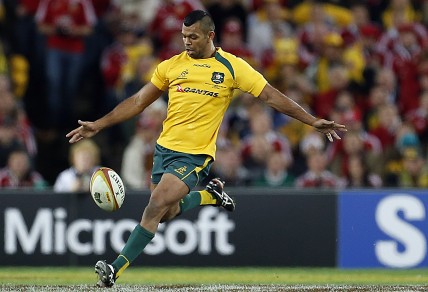
He’s been good, but Kurtley Beale hasn’t reached the superstardom his school performances hinted at. (Photo: Paul Barkley/LookPro)
Compare Beale’s rugby career with that of Beauden Barrett, a similar type of player. In his 59 Tests, Barrett has played in a Rugby World Cup champion team, won a Super Rugby title and was given the temporary captaincy of the All Blacks when Kieran Read was allowed a week off from the 2017 European tour. He has never been dropped from the national team, and has avoided the sort of off-field issues that dogged Beale in his days as one of the ‘Three Amigos’, and later in the Di Patston controversy.
When his playing career is over, hopefully well into the future, Beale might well be remembered less for his rugby exploits and more for his pivotal role in helping to create the Indigenous Wallaby jersey that inspired Australia to defeat the All Blacks at Brisbane in the third Bledisloe Cup Test of 2017.
Just look at this article published by Welcome To Country.
“The Wallabies can be proud to have elevated Indigenous culture to the international sporting arena. Indigenous player Kurtly (sic) Beale has been the driving force behind this dream. He was inspired not only by the All Blacks HAKA but also by New Zealand’s and South Africa’s national anthems that are sung in two languages. The playing group also made sure that the Welcome to Country ceremony was promoted to the same stage as the national anthems.”
This push to come to terms with his own Aboriginality has been a long time coming for Beale. It is a journey that is closer to its beginning than its end, which may well be the explanation why his career has been marked with unacceptable behaviour off the field and has not entirely fulfilled the high hopes held by so many on the field.
We can probably pinpoint the year when Beale became aware that he had to look to his Aboriginality as a source of strength to guide his behaviour off the field, freeing him to play with more responsibility.
That year was 2014, five years after he first played for the Wallabies.
In 2014, Beale was fined $45,000 for his involvement in the Di Patston texting scandal. Under instructions from Rugby Australia, the fine money was handed over to the Lloyd McDermott Development Team – a life-coaching project created by the first Wallaby to identify as an Aborigine – which recognises and helps promising Indigenous youngsters in sport and education.
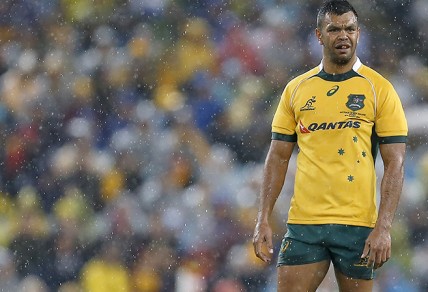
2014 saw Kurtley Beale embroiled in controvery. (Photo: Paul Barkley/LookPro)
In a sense, by bringing the Lloyd McDermott Development Team into his life, Rugby Australia helped Beale, who in 2011 didn’t know which mob he came from, to think seriously about himself as an Indigenous person.
As Beale told Phil Lutton in a candid interview for the Sydney Morning Herald in 2015, this effort to find the pieces of the jigsaw puzzle of his life was a difficult process to manage.
“It was very hard to follow back my family tree. I couldn’t really find the elders to pass down the knowledge to me. I was born in Blacktown, so my people are the Darug people. That’s where I was brought up. My mum’s part of the Kamilaroi tribe and that’s one of the biggest tribes in NSW, that’s out west,” Beale said.
“I think, talking about it, for me there’s still a little bit of uncertainty, which is kind of disappointing. I’m sure there are people that can help and I’ve been trying to focus on myself and trying to get my life right before I do that. But one day down the track I really hope to sit down with someone and work it all out.
“I’ve said that to a number of people, that once I do find that true identity, then I’ll be able to feel a bit more secure with myself and have a lot more belief in myself and the things I do.”
By way of contrasting Beale’s uncertainty of his origins, we should note that when the New Zealand Maori All Blacks side is announced, the home tribe of each player is listed beside his name. It would be unacceptable for a prominent Maori not to know his tribe, his place in the tribe and the history of his tribe.
To know yourself, you have to know and acknowledge your origins.
This is a task that confronts the Australian rugby community and its relationship in the past with its Indigenous players.
And this brings us to the future of the Indigenous Wallaby jersey.
The national jersey has been invested with a chaotic concoction of colours since Australia’s first Test, in 1899. One edition in the 1990s was so dire it was designated by some journalists as a “dog’s vomit” of patterns and colours.
In this commercial age, admittedly, sporting teams often change the colour or special details of their uniforms several times a season. This money-mad rush exploits the passion of supporters and thwarts the creation of special tradition based around a colour or colours that have been worn proudly over the decades through tough times and during years of triumph and greatness.
One edition of the Wallabies jersey in the 1990s was so dire it was designated by some journalists as a “dog’s vomit” of patterns and colours.
In their first Tests, the Wallabies played in the light blue of NSW in Sydney and the Queensland colour of maroon in Brisbane.
Later, the outfit stabilised as a green jersey and gold shorts.
Then, to avoid a clash with the Springboks’ green jersey on the 1961 tour of South Africa, the outfit of a gold jumper and green shorts was adopted.
The gold jumper has been worn by the Wallabies since. But, and this is an important qualification, there have been variations of the gold colouring, from a pumpkin yellowy-red to the current Wallaby gold, and many stylistic adjustments to the body of the jersey, ranging from man-boob lines to green and white flashes and stripes.
All these changes and adjustments have worked against players and supporters establishing a rapport and love for the jersey. The essential feature of an iconic jersey, surely, is that it doesn’t change.
How can you have a passion and reverence for the Wallaby jersey, as New Zealanders do for their all-black colour scheme, when it changes from year to year?
The 2017 Brisbane Test at Suncorp Stadium was a historic occasion because it marked an official recognition of the 14 Indigenous Wallabies. This included the overdue acknowledgement that Cecil Ramalli, a Wallaby in 1938, was the first ever Indigenous person to represent Australia in any sport.
Overdue, because it was known by many people in the rugby community for many years.
Admittedly, Ramalli refused to recognise his Aboriginality during his playing career, but he talked about it when he was retired. Despite his reticence, he was named by Jack Pollard in Australian Rugby: The Game and the Players and by myself in a history of Australian and New Zealand Test rugby, Two Mighty Tribes, as the first Indigenous Wallaby. These mentions were published about 20 years ago.
The Indigenous jersey that was created to mark, finally, Ramalli’s special status and the contribution of his fellow Indigenous Wallabies, mixed and matched the basic gold colour with traditional Indigenous motifs.
The Indigenous jersey has the power to do for the Wallabies what the black outfit does for the All Blacks.
A stylised wallaby embellished the jersey and surrounding it were 14 waterholes, each of them representing one the 14 Indigenous men who have played Test rugby for Australia: Cecil Ramalli, Lloyd McDermott, Mark Ella, Glen Ella, Gary Ella, Lloyd Walker, Andrew Walker, Jim Williams, Wendell Sailor, Timana Tahu, Saia Fainga’a, Anthony Fainga’a, Matt Hodgson, and Kurtley Beale.
The jersey was designed, brilliantly, by Dennis Golding Weatherall, a Kamilaroi/Gamilaraay man.
As they ran out onto Suncorp Stadium wearing this stunning jersey, I was immediately electrified with the notion that the players were wearing the iconic Wallaby jersey that Australian rugby has been searching for since 1899.
Judging by the intense, passionate, prideful and winning manner they played during the Test, the Indigenous jersey has the power to do for the Wallabies what the black outfit does for the All Blacks.
So I present this modest proposal to Rugby Australia: the Indigenous jersey should become the official Test jersey for the Wallabies.
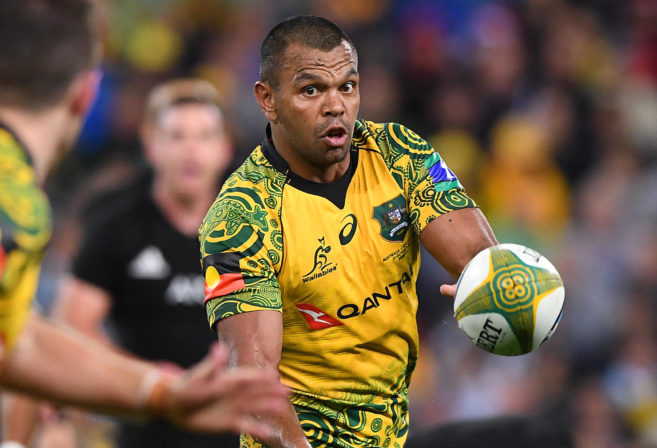


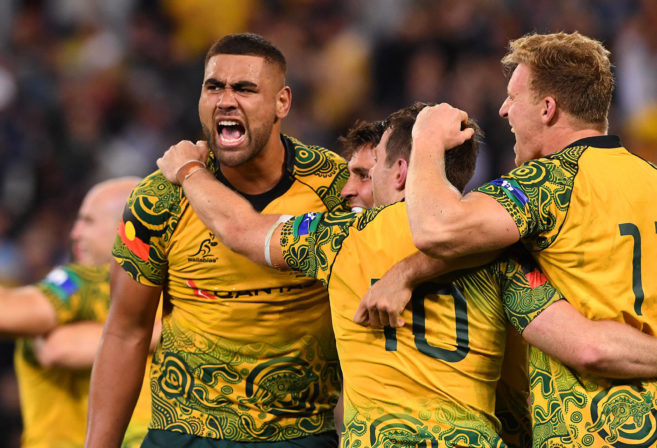

Why did it take so long for the Australian rugby community to honour Cecil Ramalli’s special status?
Ramalli was born in Moree in 1919 and died at Budgewoi, on the NSW Central Coast, in 1998.
He played for the Wallabies in two Tests against the All Blacks in 1938. A rugby prodigy, he had quicksilver pace from the scrums and rucks, his pass was sharp and accurate, and he was a ferocious and accurate tackler, despite his small size.
From everything I have read about his halfback play, the picture that comes to mind is that he was a combination of Ken Catchpole, with his brilliant running and the speed and accuracy in his passing, linked with a George Gregan-like zest for making crucial tackles.
The All Blacks, anyway, paid Ramalli the ultimate compliment by smashing his nose and concussing him in his second Test with an elbow to the head.
In his lifetime, Ramalli – named Ali Ram, but changing it to the less exotic Ramalli when he came to Sydney to play rugby – admitted to being the son of an Indian-born camel driver, but not to having an Aboriginal mother.
In an excellent article in the Australian, published on the morning of the Brisbane Test, Wayne Smith explained why Ramalli never identified as Indigenous, even though he accepted the accolade of being the first Asian to play for the Wallabies: “Racial harmony has still a long way to go in this country but in the 1930s the oppression was so much worse, and it was not uncommon for Aborigines to hide their true identity.”
Then Smith made a couple of assertions that I find perplexing
“Until now, Aboriginal fast bowler Faith Coulthard has been hailed as the first Indigenous athlete to compete for Australia, in 1958, (the 1868 all-Aboriginal cricket team that toured England was not officially recognised as a representative team), while Lionel Morgan led the way in rugby league in 1960 and McDermott in rugby in 1962. Indeed, McDermott still is acknowledged as the first rugby international — by no less than the Australian Rugby Union’s own website which, even today, remains unchanged.
“How Ramalli remained so anonymous is a mystery because the Guardian newspaper wrote his story in 2015. But it was only last year that the ARU even became aware of his background and set to work repairing its history. The Indigenous jersey, which Beale especially will wear with such pride at Suncorp Stadium on Saturday, certainly goes a long way to placing him squarely where he belongs in history.”
It simply is not factual to make the case, as Smith has, that Patrick Skene’s 2015 article in the Guardian, ‘The forgotten story of … Wallabies star and Nagasaki survivor Cecil Ramalli’, was the first time Ramalli was revealed as “Australia’s first Aboriginal and Asian Wallaby”.
Skene’s article admittedly does have the great merit of being the most authoritative account of Ramalli’s life and rugby story.
After his first Test, for example, Skene reports that Ramalli was regarded as the standout Wallaby on the field, with the Courier Mail reporting, “Ramalli made such a splendid debut, he should become one of the greatest players the game has produced.”
There is a detailed account of the aborted tour of the British Isles by the third Wallabies, and then of Ramalli’s experiences during and after the Second World War.
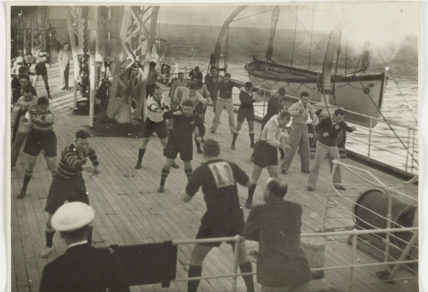
The third Wallabies training on the deck of the ‘Mooltan’. The captain, Vay Wilson, is in the foreground. (Image: Mitchell Library, State Library of New South Wales)
Ramalli was serving with the Signallers 8th Division in Singapore when he was captured by the Japanese and sent to Changi prison camp, where from time to time he was treated by the famous surgeon and former Wallaby, Ernest Edward ‘Weary’ Dunlop.
Before being repatriated to Sydney at the end of the War, Ramalli worked in the mines at Nagasaki and survived the atomic bombing of the city because he was underground at the time.
Skene’s fine piece of journalism will be a key document in establishing all the crucial facts when a smart producer gets around to making a film about Cecil Ramalli’s remarkable life story.
But it is not, as Smith suggests, the first time that Ramalli’s Indigenous background had been documented.
As long ago as 1994, Ramalli’s ‘secret’ was revealed in an easily verifiable way.
Surely the general ignorance of the rugby authorities over a period of over 20 years about the background of the first Aboriginal Wallaby raises serious questions about their interest in a line of players that Professor Colin Tatz, in his pioneering account Obstacle Race: Aborigines in Sport, calls the “black diamonds” of Australian rugby.
The real story of Ramalli’s origins was first published in the second edition of Australian Rugby: The Game and the Players, a masterpiece of information, facts and social history, which was written by the late veteran author and journalist Jack Pollard.
Every Wallaby up to 1994 has an entry in the book, as well as coaches, rugby identities and personalities, in over 800 biographies. The scores of every Test played by the Wallabies is recorded and the scorers; every tour, at home and abroad, is covered; the history of the rugby game in each state is detailed; there are numerous other entries of match appearances, crowd attendances, referees, defections to rugby league, grounds, uniforms and a detailed bibliography.
“Until publication of this book, the records of rugby football in Australia were in a complete disarray,” Michael Lynagh writes in his foreword.
“Two disastrous fires at the Sydney headquarters of the Australian Rugby Football Union burnt all the ARFU’s records of matches, players and tours stretching back to the 1880s or even earlier … In Brisbane, the other main centre of the game, there were virtually no records of value before the sport set up its headquarters at Ballymore in 1967.
“To find the material for his book, Jack Pollard has had to interview hundreds of old players, and spend weeks in newspaper offices going through accounts of matches played over a century ago. He has been to funeral parlours to secure details on star players’ lifespans, visited graveyards to check on the year of their death, and painstakingly worked his way through dozens old match programmes.”
Some rugby writers have dismissed this marvellous book as being riddled with mistakes. It is true that some of the details are wrong – Ramalli’s death date in his entry is listed as 1991, whereas Skene spoke to his son and gives the year as 1998.
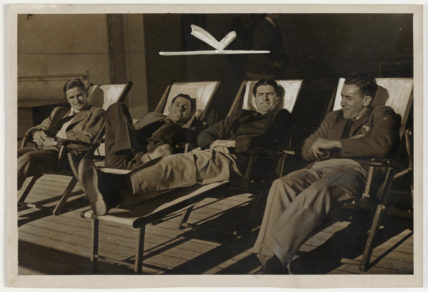
Cecil Ramalli (far right) with Paul Collins, Basil Porter and Des Carrick in 1939. (Image: Mitchell Library, State Library of New South Wales)
Mistakes like this have to be accepted in an undertaking as huge as the one Pollard embarked on. Sometimes it took months to get details of a single fact, say the birthdate of a player. Pollard’s achievement is immense. He singlehandedly restored the history of rugby in Australia from oblivion.
And with his history, he allowed rugby’s forgotten heroes, like Cecil Ramalli, to be remembered and cherished.
In his foreword, Pollard noted an update from the first edition, published in 1984, for the second edition: “Recent research has also necessitated revisions to the section on our Aboriginal footballers, with Lloyd McDermott and the Ellas appearing a long time after two of their race who played for Australia in 1938, John Howard and Cecil Ramalli.”
The entry on Ramalli established his unique place in the story of Australian rugby. The last paragraph of the entry alluded to the reasons why this unique place was not acknowledged when he was selected for the Wallabies:
“One of the first Aboriginals to play for Australia, a halfback of exceptional brilliance who combined a long pass with speed and strong tackling. His football career was finished after he was taken prisoner of war by the Japanese.
“Ramalli was the son of an Indian-born camel driver who settled in Mungindi in northern NSW and married an Aboriginal. He changed his name from Ali Ram before he went to Hurlstone Agricultural College…
“After his repatriation, his health broken, he devoted himself to coaching young players. He left the Sydney scene believing (mistakenly) that a colour bar operated against him when he failed to get a job as NSW Sports Foundation rugby coach.”
The entry on John Howard, a speedy winger who played in two Tests for the Wallabies against the All Blacks in 1938 along with Ramalli, named him as “one of the first Aboriginals to play for Australia”, but did not provide documentary evidence of the assertion: “‘Jockey’ Kelaher who replaced Howard in the final Test of the series said Howard was an Aboriginal.”
For this reason, presumably, Pollard mentioned Wallaby John Howard as a player of Aboriginal descent but did not make a claim for him to be officially recognised like Ramalli.
Coming from New Zealand – where a Maori, Dave Gage, was the first captain of a national side, where the first superstar of New Zealand rugby, George Nepia, was a Maori, and where the national Maori side is ranked only one position down from the All Blacks and has played Test rugby – it was a surprise that Aboriginals and aspects of their culture, which contributed strongly to the local game, received little acknowledgement.
I discussed this matter a lot with Pollard and with Professor Tatz, a South African-born academic who pioneered major studies into Aboriginal sporting stars.
The fact is it was not unusual for people of Aboriginal origin to hide their background when they were players. This is what Ramalli did, after all.
These discussions, a lot of research, and much thinking culminated in an article I wrote for the Sydney Morning Herald in June 2000, for which a clever sub gave the heading: “Prejudice and a Wallaby called John Howard”.
The article made the case for Howard being acknowledged, officially, as the first Indigenous Wallaby:
“Rugby, generally, despite its unthinking acceptance of the Aboriginal stereotype, has a good record of its treatment of Aboriginal players. Even when it was an amateur game, it tried to be inclusive. It gave representative caps to outstanding Aboriginal players when, say, cricket did its best to force them out of the game.
“Most of the following information which supports this thesis comes from two outstanding books research, Black Diamonds by Colin (text) and Paul Tatz (photos), and Australian Rugby: The Game and the Players by Jack Pollard.
“The title of Black Diamonds is taken from an item in a sporting magazine which in 1879 reported that an unnamed ‘sable party’ from North Queensland had turned his back on ‘money, baccy and grog, to run professionally.
“‘There’s a gold mine in this black diamond,’ the magazine noted. This news item provides an explanation why some Aboriginal athletes, right up to the present day, are unwilling to be known as Aborigines. They have not wanted to face up to the hostility other Aborigines have to endure.
“Like many gays, and for the same sort of reasons, they have been reluctant to be outed.
“This seems to be the case with John Howard whom Jack Pollard names in his rugby history as the first Aborigine to play rugby for Australia … Howard played for Queensland in 1937 and for the Wallabies in the first two Tests against the All Blacks in 1938. (Cecil Ramalli played in the second and third Tests in 1938).
“Howard, who was known to his friends as ‘Jack’ or ‘Blondie’, was described as a ‘solid, strong-running winger’ by Ian Diehm in his history of Queensland rugby, Red! Red! Red!
“Diehm quotes a teammate, Cyril Andrews, saying: ‘He certainly was no Aborigine. They’ve got him mixed up with Bernie Howard.’
“But Pollard is sure of his research. The winger Howard displaced in the Wallabies, John ‘Jockey’ Kelaher, and Joe French, a former president of the ARU and a teammate of Howard’s, told him that they ‘were adamant that Howard was an Aborigine.’
“Unfortunately, the records relating to Howard have been lost. According to Pollard, he is believed to have died in a prisoner-of-war camp, but the army has no record of him.”
Was John Howard the first Aboriginal Wallaby?
The fact he was nicknamed ‘Blondie’, an example possibly of Aussie laidback irony, is more a positive than negative in establishing his Indigenous claims. As also is the witness of Joe French, one of the great rugby administrators and characters coming out of Queensland.
With Cecil Ramalli now rightly restored to the pantheon, it is perhaps time for some deep research into John Howard’s life story.
But, unlike the case of Ramalli, there is no direct evidence from the player himself.
The fact is it was not unusual for people of Aboriginal origin to hide their background when they were players. This is what Ramalli did, after all.
Aborigines had virtually had no civil rights in the 1930s. They could not vote. The Aborigines Protection Board, with its unfettered power of the movements of Aborigines, particularly in Queensland, ‘protected’ many from living a satisfying life in the wider community. And Wallaby John Howard was a Queenslander.
Aborigines could be placed in missions or reserves and forced to try and conduct a sporting career, such as the unfortunate fast bowler Eddie Gilbert attempted, with the active hostility of administrators.
Howard would have had very good reason, therefore, for trying to hide his background, and his teammates, like French, collaborated in the deception while providing a wink-wink with his nickname.
With Cecil Ramalli now rightly restored to the pantheon, it is perhaps time for some deep research into John Howard’s life story to establish definitively, if possible, whether is he actually the first of Australia’s ‘Black Diamonds’.
Professor Tatz’s Black Diamonds was launched at the SCG by the brightest of the Diamonds, Mark Ella – my favourite Wallaby.
Ella told the audience that he got angry when people spouted the nonsense that he and his brothers were stereotypical Aboriginal ‘naturals’. Hours of practice, a toughness of mind and body, flair, imagination, and a great deal of thinking about rugby tactics and strategy, he insisted (correctly), were the key to the ‘Ella Magic’.
It was hard work, in other words, that made the Ellas look like naturals.
He also attacked another false stereotype, that the best Aboriginal players relied on sheer speed and instinctive skills but were flighty and inclined to go ‘walkabout’ under pressure.
When Ella was making these comments, the only recognised Wallaby Aborigines were backs: Lloyd McDermott, Mark Ella, Gary Ella, Glen Ella, Lloyd Walker and Andrew Walker.
The ‘speed and skills’ stereotype was broken in June 2000, when Jim Williams, a big (193cm and 115kg), tough loose forward with a high work-rate was named for the Wallabies to play Argentina at Ballymore.
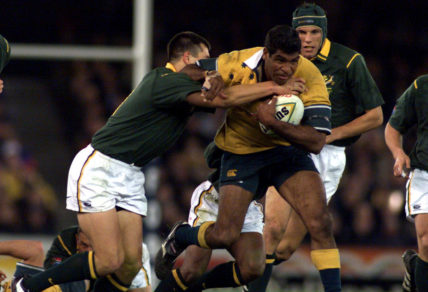
Jim Williams was the first Indigenous Australian to play in the forwards for the Wallabies. (Image: Hamish Blair/ALLSPORT)
The first Indigenous Wallaby to play in the forwards, Williams has since been joined by Matt Hodgson and the Fainga’a brothers – the latter three all being relentless, on-the-ball forwards, totally shattering the stereotype of the ‘walkabout’ tendency.
On the morning of the 2017 Brisbane Test, Mark Ella wrote a hard-hitting column in the Australian, making some pointed comments about the lack of respect for Indigenous players shown by the Australian rugby community over many decades:
“Other major Australian sporting codes, particularly Australian rules and rugby league, have for many years honoured the contributions of Indigenous players. The ARU are finally catching up.
“I am not sure why it has taken rugby so long to recognise Indigenous participation but it is better to be acknowledged than not at all.
“I note with interest that my brothers Glen and Gary were in Brisbane on Thursday for the appropriate picture opportunities and Wallabies Indigenous jumper presentation, which I hope gives the Wallabies a little more to think about leading into today’s match against the All Blacks.
“I should have been there myself alongside my brothers, but I couldn’t help thinking that this is a novelty rather than a sincere effort from our leading body to acknowledge the 14 Indigenous players from the total of 914 players to have worn the Wallabies jersey…
“The fact only 14 Indigenous players in the history of Australian rugby have represented their country doesn’t fill my heart with much joy when you look at how many Maori have played for the All Blacks over the past 100 years.”
Some weeks earlier, in another hard-hitting Australian column, Mark Ella wrote about the experiences of his brother Glen in trying to get a coaching job in Australia and the hostility he faced, even from Michael Cheika, when he highlighted the lack of skills the current Wallabies last year:
“Glen, who as we all know was seconded to help the Poms by his close friend Eddie Jones, was writing for a website in Australia that was getting picked up by the mainstream papers.
“That is not unusual but it really irked Wallaby coach Michael Cheika, mainly because Glen kept on emphasising the obvious lack of skill level with Australian professional players and Super Rugby teams.
“Leading up to the Test series against England, Cheika also went out of his way to mention the learned opinion from my brother would have no direct influence on the Wallabies once they got into camp.
“Well what an embarrassing statement that was as the Wallabies lost the England series 3-0 and only won six out of 15 matches last year.”
The punchline in this attack, aside from the obvious point that Glen Ella’s coaching of skills to the England players was superior to the coaching in the Wallabies camp, is that he has been constantly rejected by Australian franchises and the national team from being appointed to a coaching role.
England were prepared to use Glen Ella. But not Australia.
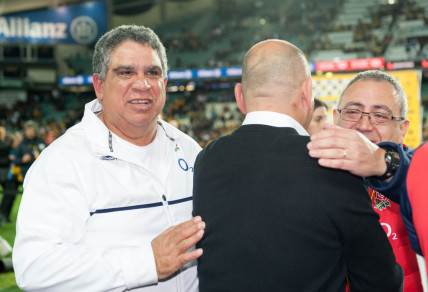
Glen Ella helped England to a 3-0 whitewash over the Wallabies in 2016. (Photo by Tim Anger)
For about 20 years, Mark Ella has been invited to present Test jerseys to the Wallabies. Each time he declined. But last year, before the third Test against England, his old friend Michael Cheika convinced him to do the honours.
“I have been a bit removed from the Wallabies and Australian rugby, so maybe it was an opportunity for me to bite the bullet and become more sociable,” he told the Daily Telegraph’s Iain Payten.
But this was a one-off concession. His articles in the Australian leading up to the Brisbane Test have continued to be unyielding about the way the rugby authorities have neglected Indigenous players and coaches.
The disappointment is personal, I would think. In May 2016, it was reported that Mark Ella would co-chair the National Aboriginal and Torres Strait Islander Cricket Advisory Committee.
You have to ask yourself why Rugby Australia has not offered Mark Ella, an Australian rugby legend, a similar advisory role.
And then we have the case of Lloyd McDermott.
The first Wallaby to acknowledge the fact that he was an Aborigine when he was capped against the All Blacks in 1962, McDermott did attend Bledisloe 3. However, he made it clear in an interview with the Herald that his rugby career had been fraught with prejudice:
“Yes, there was racism. A bit of in-your-face racism and a fair bit of racism behind your back. I found that it was at the school and club level, racism was more prevalent,” McDermott said.
“When you played at state or international level, I never experienced any racism. A lot of the great rugby union players were black; Maori or Fijian or Samoan. It was more or less in the lower codes I experienced racism.”
So the sad truth is that three early standout Aboriginal Wallabies – Cecil Ramalli, Lloyd McDermott and Mark Ella – were confronted with prejudice about their race.

This prejudice is the original sin of Australian rugby.
Rugby, admittedly, inherited this stain along with all the other institutions and sporting codes in our national life. But for too long, this prejudice festered within the Australian rugby community when other sporting codes like AFL, rugby league and even cricket pushed forward with positive policies and appointments designed to right previous wrongs.
The earliest recognition in the rugby community that there was something wrong with Australia’s treatment of its Indigenous peoples and that something needed to be done about this shame came from the first truly great Wallaby captain.
Dr Herbert Moran, the forthright and thoughtful skipper of the 1908 national side – which won an Olympic gold medal at the London Games – set the standard of intelligence, honesty, excellent play and leadership, on and off the field, that created the template for future Wallaby leaders.
As captain of Australia, he was determined to promote rugby’s inclusive ethic to improve the condition and status of Indigenous peoples in the Commonwealth.
This determination collided with the Australian rugby authorities’ requirement that his team perform an Aboriginal dance before his team’s matches.
For too long, this prejudice festered within the Australian rugby community when other sporting codes pushed forward.
They wanted a ‘native dance’ along the lines of the Haka performed by the touring 1905 All Blacks and the Zulu dance by the 1906 Springboks.
Dr Moran hid behind the ranks of his teammates when they did their dance, a photograph of which Jack Pollard once showed from his archive.
On his return to Australia, Dr Moran forced the abolition of the dance, which remains in place to this day.
In his excellent history Wallaby Gold: 100 Years of Australian Test Rugby, journalist and author Peter Jenkins quotes Dr Moran’s full statement – taken from the latter’s brilliant autobiography Viewless Winds – that states in unequivocal terms why he had no enthusiasm for the Aboriginal war dance:
“The memory of the war-cry provokes anger in me even after all these years. The New Zealanders always performed their antics before the beginning of the match: but after all it was in the Maori tradition to lash themselves into some sort of fury by this picturesque method of self suggestion. In Australia, on the other hand, no club ever adopted a war cry except as comic relief. Now we were being asked to remind British people of the miserable remnants of a race which they had dispossessed and we had maltreated or neglected. We were officially expected to leap up in the air and make foolish gestures which somebody thought Australian natives might have used in similar circumstances, and we were also given meaningless words which we were to utter savagely during this pantomime. I refused to lead the wretched caricature of a native corroboree, and regularly hid myself among the team, a conscientious objector. None of the men liked it.”
After the famous victory at Brisbane, these supportive messages for the special jersey initiative appeared on Twitter.
If the Wallabies win the new jersey should stay. ?
— Paul Cully (@whiskeycully) October 21, 2017
The wallabies should wear the ABORIGINAL jersey always (-0-) ??
— Anthony Mundine (@Anthony_Mundine) October 21, 2017
Brilliant win. Great jersey. Well done Wallabies! https://t.co/aN3Vf4W4RN
— Malcolm Turnbull (@TurnbullMalcolm) October 21, 2017
Any chance of the #Wallabies playing in that Indigenous jersey every week? We're 100% so far
— Mick Snowden (@MickSnowden) October 21, 2017
In August 2010, the Wallabies played the All Blacks at Christchurch, with three players of Aboriginal descent in the starting line-up: fullback Kurtley Beale, centre Anthony Fainga’a and his twin brother and hooker, Saia Fainga’a.
An Aborigine, Jim Williams, was on the coaching staff.
Is it a coincidence that the head coach of the Wallabies at the time was Robbie Deans, a New Zealander? Deans, anyway, made it one of his projects to rehabilitate Beale as a player and a person. He spent time, for instance, kayaking with Beale on Sydney Harbour as part of this healing process.
The Wallabies side that ran out onto the field wearing the Indigenous jersey at Brisbane contained only one Indigenous player, Beale. This outcome raises the question whether the push for respect for Indigenous players that Deans was concerned to maintain has been thwarted slightly in the last six years.
The best answer to Mark Ella’s challenge to Rugby Australia to prove its support for Indigenous players is “not a novelty” is this: make the Indigenous Wallaby jersey the official outfit for Australia’s national rugby team for every Test, and not just once a year.

Written by Spiro Zavos.
Spiro is a founding writer on The Roar, and long-time editorial writer on the Sydney Morning Herald, where he started a rugby column that ran for nearly 30 years. Spiro has written 12 books: fiction, biography, politics and histories of Australian, New Zealand, British and South African rugby. He is regarded as one of the foremost writers on rugby throughout the world.
Editing by Joe Frost and Daniel Jeffrey
Design by Daniel Jeffrey
Lead image credit: Bradley Kanaris/Getty ImagesImages of Australia versus New Zealand in Brisbane credit: AAP
Image of Lloyd McDermott, Kurtley Beale and Gary Ella credit: Matt King/Getty Images




























































































